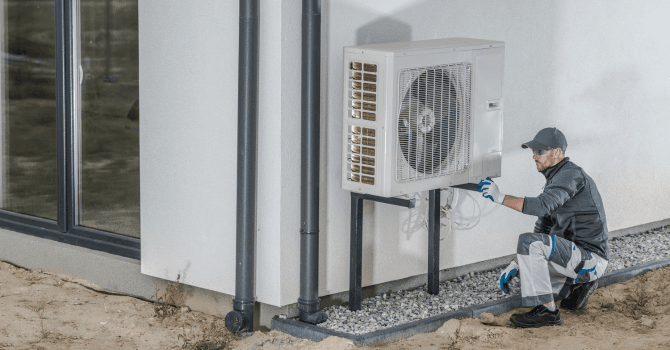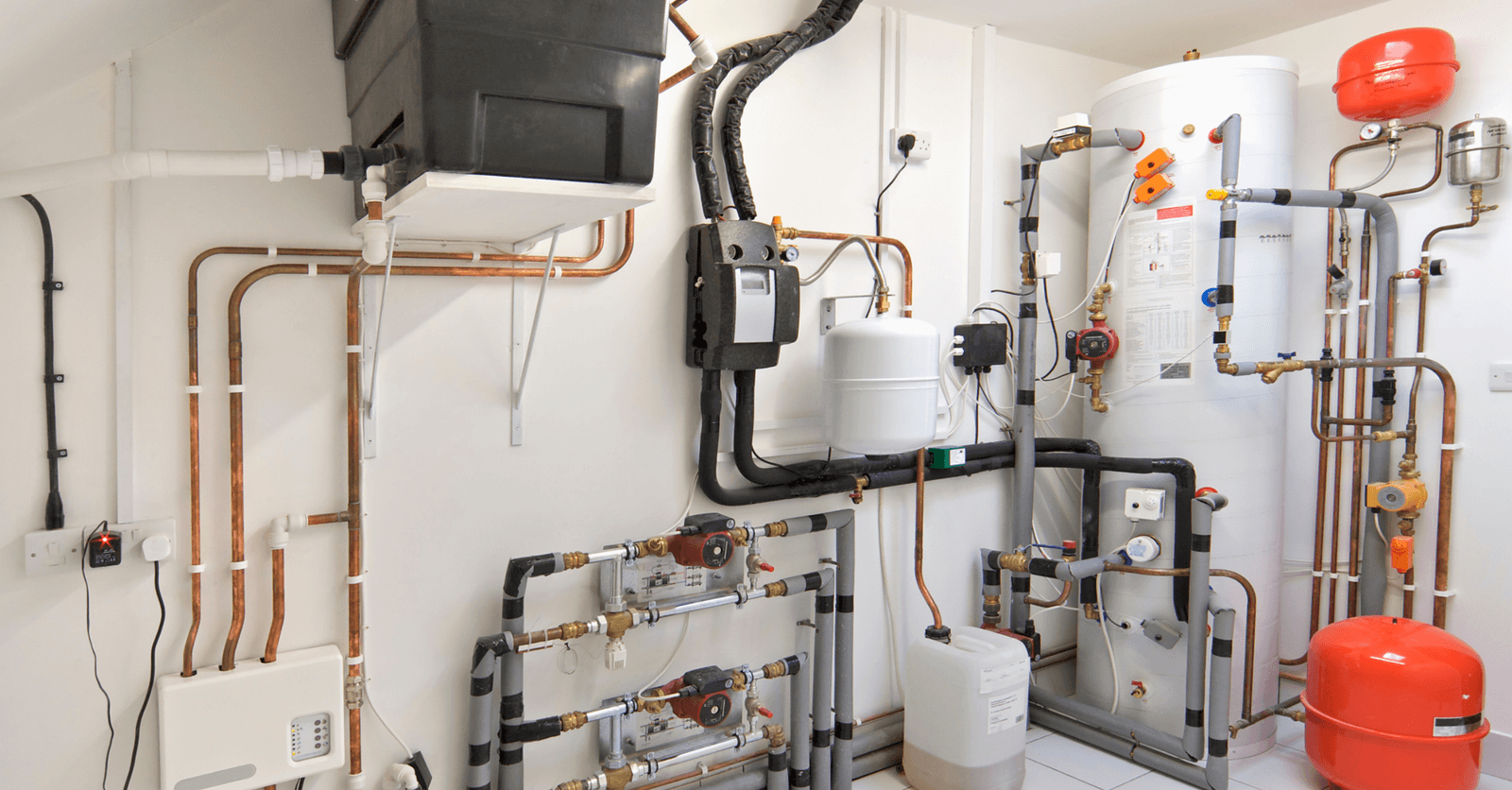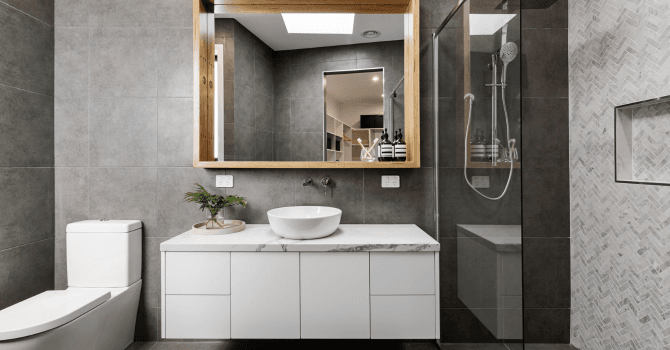Benefit From the Versatility of a Heat Pump for Heating and Air Conditioning
By Editorial Team
Updated on May 15, 2025

There’s such a thing as a device that blows both cold and warm air—a heating and cooling heat pump. But, rest assured, there’s nothing sorcerous about it, it’s all about physics.
Learn more about its functioning and must-know factors to choose the device that best meets your needs, but also your budget. Maintaining a comfortable ambient temperature in your home will never have been this economical.
How a Heat Pump Both Heats and Cools
There are 4 heat pump models:
Geothermal heat pump;
Ductless air-to-air;
Air-to-water.
1- Air-to-air heat pump

Source: Canva
These are the most common heat pumps. Their motor is located outside the home and, depending on the chosen functioning mode, can warm up or cool down the air dispensed. Since this heating system is reversible, you can thus benefit from a heating and cooling heat pump.
Air-to-air heat pumps are composed, in circuit order, of the following elements:
Compressor;
Reversing valve;
Heat exchanger inside coil;
Thermostatic expansion valve;
Check valve;
Filter dryer;
Control light;
Second thermostatic expansion valve;
Second check valve;
Heat exchanger outdoor coil;
Controller.
This circuit is supplied with a liquid refrigerant (which we'll discuss later in our article).
In heating mode, the compressor dispenses, at high pressure, this liquid as scalding hot steam into the circuit.
The liquid is dispensed via the reversing valve, which is positioned in heating mode to again increase the temperature of the liquid. The liquid is channelled along into the heat exchanger’s inside coil.
By heating a room with the coils, the liquid loses its energy which it transferred into the house in heat form. As such, it foregoes its purely gaseous form to become ever more liquid.
Said liquid will bypass the thermostatic expansion valve by flowing through the check valve, through the filter dryer, and control light before finally flowing through the thermostatic expansion valve.
At this stage, the liquid refrigerant’s pressure will have diminished just like its temperature. It will flow through the heat exchanger’s outdoor coil. The goal is rather simple: give it back the calories it lost inside the house using the outside air, and send it back to the compressor via the reversing valve.
In air conditioning mode, the circuit is inverted by the reversing valve.
2- Air-to-water heat pump

Source: Canva
This heating system is composed of the following parts:
Compressor;
Plate heat exchanger;
Hot water cylinder tank;
Filter dryer;
Control light;
Thermostatic expansion valve;
Heat exchanger outdoor coil.
With air-to-water heat pumps, there are two coexisting circuits. In the first one, the liquid refrigerant leaves the compressor and flows through the heat plate exchanger (circuit 1), which is its point of contact with the second circuit.
Once the liquid leaves the compressor, it’s under high pressure, thus at an elevated temperature. It then flows into the heat plate exchanger in which it’ll swap its heat with the water that’s coming from the hot water cylinder tank and flow back toward it (circuit 2).
The water is thus heated thanks to circuit 1. The liquid refrigerant wasted its calories in favour of the water in circuit 2, which returns warmer to reach the house’s heating devices.
In circuit 1, the liquid’s pressure decreases, thus becoming colder. It then flows through the filter dryer, control light, and then the thermostatic expansion valve. The latter partially liquefies the fluid, to make its way to the heat exchanger's outdoor coil.
There, the refrigerant, in contact with the outside air, will start boiling and steaming again, before flowing through the compressor to start the cycle again.
3- Geothermal heat pump

Source: Canva
There are two models of geothermal heat pumps:
Vertical;
Horizontal.
These two heat pump models work the same way. The only difference between their circuits and that of air-to-water heat pumps is the presence of a third circuit that’s linked to the second exchanger.
This third circuit contains a mix of water (75%) and methanol (25%), which is sent deep into the ground to draw out the heat contained in the soil.
How to Choose an Efficient Home Heat Pump

Source: Canva
Two important factors to consider when choosing a heat pump:
The SEER
Heating and cooling heat pump manufacturers developed the seasonal energy efficiency ratio (SEER) to give consumers an accurate picture of the efficiency of the heat pumps made available. The higher the value, the more energy you save.
Our advice, if you want to avoid buying the wrong heating and air conditioning system, is to select a heat pump with a SEER of at least 14.
However, since January 1st, 2023, the SEER was updated to account for real weather conditions during laboratory testing. Thus, one doesn't refer to SEER anymore, but rather to SEER2.
The HSPF
The heating seasonal performance factor (HSPF), is an indicator that shows how much energy is needed to produce a certain quantity of heat.
The higher the HSPF, the more efficient the heat pump. Heat pumps having an HSPF equal to or higher than 9 are considered efficient. However, not unlike the SEER, the HSPF also has evolved and is now known as the HSPF2.
Government of Canada guidelines regarding heat pump models
The Government of Canada suggests the following SEER2 and HSPF2 ratings for the listed models of heating and air conditioning heat pumps:
Heat pump models | SEER2 and HSPF2 |
Single package central air conditioner | SEER 2 higher than 11.6HSPF 2 higher than 5.4 |
Space-constrained single package central air conditioner | SEER 2 higher than 11.8HSPF 2 higher than 4.9 |
Single package central heat pump | SEER 2 higher than 13.9HSPF 2 higher than 6.9 |
Space-constrained single package central heat pump | SEER 2 higher than 11.9HSPF 2 higher than 6.3 |
What’s the best brand of heat pumps in Quebec?

Source: Canva
Activa is the only Quebec-based brand from which you can purchase a heat pump. It’s manufactured by TTI Fabrication Inc., a Longueuil-based company.
However, this local business has to deal with fierce international competition. The all-time best brand of heat pumps seems to be the Japanese brand Mitsubishi Electric.
Popular amongst customers for its reliability and sturdiness, it stands head and shoulders above other highly regarded companies in this industry, such as:
Goodman;
Carrier;
Gree;
Fujitsu.
When choosing a heating and air conditioning heat pump between all these brands, you have to compare their materials. Don't forget to look for the 2 important factors above-mentioned, the SEER2 and HSPF2 ratings.
That way, you’ll be able to select a heating and cooling heat pump that meets your needs and your budget.
Cost of Central and Wall-Mounted Heat Pumps

Source: Canva
A wall-mounted heat pump costs between $900 and well over $11,000. Naturally, you may ask yourself why home heating costs so much. The price difference can be explained by 2 factors. Wall-mounted heat pumps can be:
Single-split;
Multi-zone.
The single-split heat pump solely has one indoor unit located in the residence. On the other hand, the multi-zone units have several wall-mounted units. Knowing that each unit has a power range of 9K to 18K, these heating and cooling heat pumps can generate up to 36,000 BTU.
The starting cost of a central heat pump is $8,000. However, this model doesn’t have wall-mounted units. The outdoor unit is directly connected to your heating or indoor ventilation system’s air ducts.
To help you narrow down your decision, check out our article Choosing Between a Wall-Mounted or Central Heat Pump.
Get 3 quotes for your heat pump installation project
RenoQuotes.com can help you get quotes for your air conditioning and heating project. If you submit your project, we’ll put you in contact with top-rated contractors. Fill in the form on the homepage (it only takes a few minutes), and you will get estimates from trusted professionals.
Dial 1-844 828-1588 to speak with one of our customer service representatives.
Looking for something else?
Related articles
The latest industry news, interviews, technologies, and resources.

Editorial Team
•24 Jan 2025
In the latter part of 2022, Steffes, in collaboration with Hydro-Québec, had already supplied 75 households with a central heating system with electric thermal storage and was expecting 100 more orders. Maybe you’ve heard about it? What is it exactly, and how does it work? Well, it’s an innovative solution that might just revolutionize heating.

Editorial Team
•19 Sep 2025
In a competitive market like construction and renovation in Quebec City, HVAC contractors need to stand out to land profitable projects. Whether you specialize in heating, ventilation, or air conditioning, this article presents concrete strategies to attract new clients and grow your business in 2025, while providing reliable and locally recognized service.

Editorial Team
•07 Nov 2023
When it's time to choose a paint colour, the process can seem time-consuming. The type of lighting, cold tones versus warm, will the colour be too dark once it fully dries? All these questions could end up giving you a headache.

Karine Dutemple
•05 Dec 2025
A lot of homeowners still opt for the application of oil on their floor, whether it’s in the kitchen, the bedroom or the living room. Given its ability to bring out the grain of the wood and to let is natural charm shine trough, an oiled floor is certainly a must.

Christine Simard
•07 Nov 2023
With fall at our doors, the feeling of wanting to cuddle up in a cozy blanket with a hot beverage is being felt by many. While in relaxation mode, your bedroom's ambiance will play an important role on your mood. This is why the colour of your walls should be chosen according to what you want to reflect.